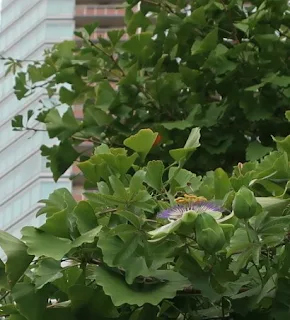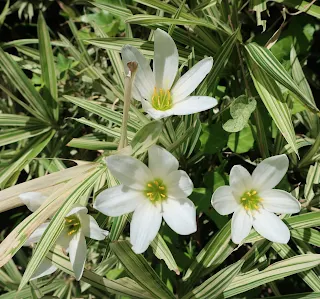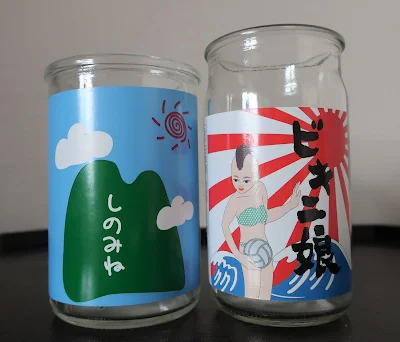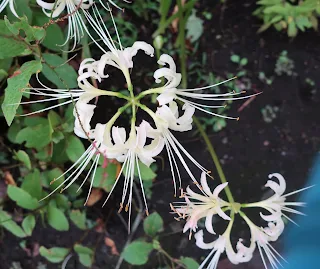Japanese follows English. 英語の後に日本語が続きます。
These are tricyrtis macropoda and tricyrtis formosana 'samurai' (maybe....😅). I saw the first one at Mukojima Hyakkaen Garden and the second in my neighborhood both in Tokyo.
Hi! I'm Kei Narujima. This is a blog about flowers🌼 and bugs🐛 (and sometimes netsuke, i.e., miniature sculpture) that make you smile😊 (or so I hope)!! こんにちは。花や虫(そして時々根付)などについて書いてます😊。税務英語については https://zeimueigo.blogspot.com/ に移行しました。
Ginkgo or Passion Flower - That's the Question イチョウの花、トケイソウの花
Japanese follows English. 英語の後に日本語が続きます。
What's this? A ginkgo flower? To me, it looks like a passiflora caerulea or common passion flower...
 |
| It's among ginkgo leaves イチョウの葉の間に発見 |
 |
| Ginkgo tree and fruit 銀杏の実 |
I couldn't first believe my eyes. It was like a passion flower or "clock flower" in Japanese. I googled to find out what this flower was, but only found that ginkgo flowers, male or female, did not look like this at all.
Ginkgo always reminds me of a former coworker, an American very popular among women. On that day, we came back to the office from a client, finding ginkgo trees with leaves turned into beautiful golden yellow but with no nuts and therefore which didn't stink. This means that all these trees were male. When I said that, he was so amazed, so I went on to ask, "Would you be sad if you had no women around you?" I knew that he thought he was attractive, and I do not like such men.....😁
Raw ginkgo nuts stink, but are delicious once roasted and of course go well with beer, highball, wine and sake😆 Autumn has come with many seasonal foods!!
Ginkgo always reminds me of a former coworker, an American very popular among women. On that day, we came back to the office from a client, finding ginkgo trees with leaves turned into beautiful golden yellow but with no nuts and therefore which didn't stink. This means that all these trees were male. When I said that, he was so amazed, so I went on to ask, "Would you be sad if you had no women around you?" I knew that he thought he was attractive, and I do not like such men.....😁
Raw ginkgo nuts stink, but are delicious once roasted and of course go well with beer, highball, wine and sake😆 Autumn has come with many seasonal foods!!
(If you wish to post your comment but don't have a Google account, select "anonymous" from the drop down menu titled "comment as"!)
近所で見かけました。何の花に見えますか。私には時計草にしか見えません。でもこれはイチョウの木。。。 家でググったのですが結局分かりませんでした。。。
イチョウといえば臭い。。。 昔、同僚とオフィスに戻った時のことです。会社の近くにイチョウ並木があり黄金色の花がとてもきれい。全く臭くなかったので何気に「ギンナンがないってことはこの辺の木は全部オスなんですね」と言ったらえらく感動されたので、さらに「メスがいないと寂しいでしょうね」と言ったらどぎまぎしてました。自分はイケテルという自覚が非常に強い方でした😁
秋です。食欲の秋です。ギンナンでチクッといきたいです😆
(Google アカウントを持ってない方は、コメント記入後に「Google アカウント」をクリックし、「匿名」か「名前/URL」を選択してからご記入ください!)
Spider Lilies, Spider Swarovski🤔 赤と白の曼珠沙華と「天然スワロフスキー」🤔
Japanese follows English. 英語の後に日本語が続きます。
Everything that day was about spiders! These are red and white spider lilies and water droplets on a spiderweb.
In Japanese, lycoris radiata or red spider lily is called "autumnal equinox flower" or "heaven or hell flower" and lycoris albiflora or white spider lily "white autumnal equinox flower" or "white heaven or hell flower." However, as I wrote in another post, a white spider lily is not the red one's sibling, but a cross-breed of the red and a yellow one (i.e., lycoris traubii). It's strange that a child of a red and yellow flowers is white, isn't it!
What surprised me more, however, was a spiderweb nearby on which many water droplets were shining like Swarovski crystals💎! They left me speechless, making me keep taking pictures...
(If you wish to post your comment but don't have a Google account, select "anonymous" from the drop down menu titled "comment as"!)
Everything that day was about spiders! These are red and white spider lilies and water droplets on a spiderweb.
 |
| Lycoris radiata 曼珠沙華 |
 |
| Water droplets on spiderweb 蜘蛛の巣のしずく |
 |
| Red spider lily 彼岸花 |
 |
| From above 上から |
In Japanese, lycoris radiata or red spider lily is called "autumnal equinox flower" or "heaven or hell flower" and lycoris albiflora or white spider lily "white autumnal equinox flower" or "white heaven or hell flower." However, as I wrote in another post, a white spider lily is not the red one's sibling, but a cross-breed of the red and a yellow one (i.e., lycoris traubii). It's strange that a child of a red and yellow flowers is white, isn't it!
What surprised me more, however, was a spiderweb nearby on which many water droplets were shining like Swarovski crystals💎! They left me speechless, making me keep taking pictures...
(If you wish to post your comment but don't have a Google account, select "anonymous" from the drop down menu titled "comment as"!)
近所で見かけた赤と白の曼珠沙華。以前も書きましたが、白花曼珠沙華は赤曼珠沙華の兄弟姉妹ではなく、赤と黄色(鍾馗水仙(リコリス))の子供(自然雑種)だそうです。
でも驚いたのはすぐそばの蜘蛛の巣。雨上がりの水滴がキラキラ光ってスワロフスキー💎みたい!こんなことってあるんですね。夢中で写真撮ってました。
(Google アカウントを持ってない方は、コメント記入後に「Google アカウント」をクリックし、「匿名」か「名前/URL」を選択してからご記入ください!)
Lespedeza or Japanese Bushclover, and Dumplings 萩より団子。。。
Japanese follows English. 英語の後に日本語が続きます。
This is lespedeza or Japanese bushclover at Mukojima Hykkaen Garden in Tokyo. The garden has a tunnel of Japanese bushclover!!
This is lespedeza or Japanese bushclover at Mukojima Hykkaen Garden in Tokyo. The garden has a tunnel of Japanese bushclover!!
Caterpillar, Beetle, Slug, and Snail, and Anpanman and Einstein 虫とカタツムリとナメクジ、そしてアンパンマンとアインシュタイン
Japanese follows English. 英語の後に日本語が続きます。
I said that in another post, but I want to say it again. I am not that interested in bugs or snails, but they are around flowers and I can't just ignore them. This post shows you pictures I took a week ago at Mukojima Hykkaen Garden and in my neighborhood in Tokyo.
I said that in another post, but I want to say it again. I am not that interested in bugs or snails, but they are around flowers and I can't just ignore them. This post shows you pictures I took a week ago at Mukojima Hykkaen Garden and in my neighborhood in Tokyo.
 |
| Having lunch! ランチ中です! |
Solanum Carolinense is "Rogue" in Japan.... 良い茄子と悪茄子(ワルナスビ)
Japanese follows English. 英語の後に日本語が続きます。
This is an eggplant flower I saw at Mukojima Hykkaen Garden in Tokyo. If you don’t believe that, look at the second picture of the flower and an eggplant!!
 |
| Eggplant flower 茄子の花 |
Snake Gourd and Bottle Gourd 蛇瓜(ヘビウリ)と瓢箪
Japanese follows English. 英語の後に日本語が続きます。
Wow!! It's long, isn't it? This is a snake gourd I saw at Mukojima Hykkaen Garden, Tokyo.
Wow!! It's long, isn't it? This is a snake gourd I saw at Mukojima Hykkaen Garden, Tokyo.
Prime Minister Suga is "Uncle Pancake"! 菅首相はパンケーキおじさん!
Japanese follows English. 英語の後に日本語が続きます。
This is a "pancake" I found on the ground😁 Oops sorry! This is a mushroom I found at Mukojima Hykkaen Garden, Tokyo.
This is a "pancake" I found on the ground😁 Oops sorry! This is a mushroom I found at Mukojima Hykkaen Garden, Tokyo.
 |
| A pancake with melted butter and maple syrup? バターとメープルシロップたっぷりパンケーキ? |
Is New Japanese Prime Minister Abe's Ex-"Wife"? 菅は安倍の「女房」?
Japanese follows English. 英語の後に日本語が続きます。
 |
| If you want to know why Columbo, read through this post! なぜコロンボ? |
If you like, or are interested in, Japan, you may know that Yoshihide Suga was elected as the new Japanese prime minister a few days ago, but do you know that Suga was the "wife" of Shinzo Abe, the former prime minister?
Of course, Suga was not Abe's real wife but was the chief cabinet secretary or "nyoubou" or "wife" of prime minister under the Abe administration.
The chief cabinet secretary is equivalent to the US White House chief of staff, and both Japanese chief cabinet secretary and US White House chief of staff support the leader of each country, but why called "wife" only in Japan?
Aulacophora Nigripennis on Bottle Gourd クロウリハムシとヘチマ
Japanese follows English. 英語の後に日本語が続きます。
I've been observing trees which I believe are bottle gourd for the last month to obtain evidence that they are really bottle gourd, not other gourds, such as cucumber, pumpkin or zucchini, and a few days ago, at last, I've got evidence, i.e., two bottle gourds hanging from one of the trees! And I also found this tiny but beautiful black and orange bug, Aulacophora nigripennis.
I can't explain why but wanted badly evidence that they were really bottle gourd, but couldn't get any proof for more than a month, just finding yellow flowers, but it was worth to wait!! The 1cm bug holding on to the yellow bud was so kawaii!! 😊
I've been observing trees which I believe are bottle gourd for the last month to obtain evidence that they are really bottle gourd, not other gourds, such as cucumber, pumpkin or zucchini, and a few days ago, at last, I've got evidence, i.e., two bottle gourds hanging from one of the trees! And I also found this tiny but beautiful black and orange bug, Aulacophora nigripennis.
 |
| Aulacophora nigripennis on bottle gourd bud ヘチマのつぼみとクロウリハムシ |
 |
| One of the bottle gourds I found 見つけたヘチマの一つ |
 |
| The other one 二本目 |
 |
| Bottle gourd flower へちまの花 |
I can't explain why but wanted badly evidence that they were really bottle gourd, but couldn't get any proof for more than a month, just finding yellow flowers, but it was worth to wait!! The 1cm bug holding on to the yellow bud was so kawaii!! 😊
(If you wish to post your comment but don't have a Google account, select "anonymous" from the drop down menu titled "comment as"!)
ウリ科の花は似ています。だからこの花もへちまと信じつつ、証拠をずっと探してました(つまり実がなるのを待ってました)。そして昨日やっと2本のヘチマを発見。しかもちっちゃい虫も!
クロウリハムシというそうです。害虫だそうですがしがみついている姿がカワイイ😊です。
(Google アカウントを持ってない方は、コメント記入後に「Google アカウント」をクリックし、「匿名」か「名前/URL」を選択してからご記入ください!)
Inro (Medicine Case) 菊花蝶象嵌印籠
Japanese follows English. 英語の後に日本語が続きます。
This white case, 6cm long and 3cm wide, is an "inro" or medicine case with chrysanthemum and butterfly design made in the 19th century in Japan. This is Shibayama inlay, a lacquer art form distinguished by high relief carved inlays made from shell, coral, tortoiseshell, and ivory.
This white case, 6cm long and 3cm wide, is an "inro" or medicine case with chrysanthemum and butterfly design made in the 19th century in Japan. This is Shibayama inlay, a lacquer art form distinguished by high relief carved inlays made from shell, coral, tortoiseshell, and ivory.
 |
| Inro (medicine case) with chrysanthemum and butterfly design 菊花蝶象嵌印籠 |
 |
| Gorgeous medicine case! 豪華! |
"Inro" is no longer used and is known as art or an ID of Mitsukuni Tokugawa (1628 - 1701) in "Mito Kōmon," a Japanese drama of the early Edo period.
In the drama, Mitsukuni, a former vice-shogun, travels across the country with his followers in the guise of a retired owner of an apparel store in the Niigata prefecture. He finds in every episode injustice perpetrated by corrupt officials, wealthy merchants and/or gangsters and punishes these bad guys using his inro with mallow design, which reveals his identity. The use of mallow design for a family crest was only allowed for the Tokugawa family during the Edo period.
This drama has a very famous line, "Can’t you see this family crest of mallow on the inro!! This is former vice-shogun Mitsukuni Tokugawa! Bow your heads! Down on your knees!" This is so famous in Japan (and funny😁 to me) that even those who've never watched this show must recognize this line.
Inro itself is just a medicine case, generally used with netsuke as shown in the picture below I found at Tokyo National Museum. Now with this easy-to-understand drawing, you see how to wear an inro and a netsuke!
 |
| How to wear inro and netsuke 印籠と根付の使い方 |
Japanese no longer use inro or netsuke in daily lives, but they are the beautiful embodiment of the spirit of Japanese manufacturing elevated to the level of art. I hope as many people as possible, not only Japanese but others, to appreciate their beauty and craftsmanship!!
(If you wish to post your comment but don't have a Google account, select "anonymous" from the drop down menu titled "comment as"!)
「菊花蝶象嵌印籠 根付線刻銘『芝山作』(19世紀)」です。「菊花蝶象嵌印籠」はまだ理解できるのですが「芝山って何?」と思って調べたところ、「レリーフ状の彫刻と象嵌を特徴とした華やかな装飾技法」だとのこと。華やかかつ精巧です。
印籠といって思い出すのは何といっても「水戸黄門」。印籠というとそのイメージしかなかったのですが、先日たまたま、東京国立博物館で印籠と根付の使い方を描いた絵を発見!言葉より絵で見ると一発です。
印籠にせよ根付にせよ、職人の技術の粋の結晶であり、「日本のものづくり精神」を体現したもの。その美しさにいつも頭が下がります。
(Google アカウントを持ってない方は、コメント記入後に「Google アカウント」をクリックし、「匿名」か「名前/URL」を選択してからご記入ください!)
Sontaku - We Trust You to Wear Mask... 忖度 - マスクしてね!
Japanese follows English. 英語の後に日本語が続きます。
On September 7, a man was removed from a flight in Japan. He refused a "request" from the airline to wear a mask, resulting in a heated argument with flight attendants.
I said "request" because Japan has no law or rule enforcing wearing masks in any place, so what the man did (i.e., choosing not to wear a mask) does not breach any law or rule. The same applies to restaurants in Central Tokyo open after 10 p.m. The Tokyo local government has requested bars and restaurants to close at 10 p.m. or before, but again it's not enforceable but just a request.
On September 7, a man was removed from a flight in Japan. He refused a "request" from the airline to wear a mask, resulting in a heated argument with flight attendants.
I said "request" because Japan has no law or rule enforcing wearing masks in any place, so what the man did (i.e., choosing not to wear a mask) does not breach any law or rule. The same applies to restaurants in Central Tokyo open after 10 p.m. The Tokyo local government has requested bars and restaurants to close at 10 p.m. or before, but again it's not enforceable but just a request.
Star of Bethlehem is "Sutaa Obu Betsulehemu" in Japanese😭 「スター・オブ・ベツレヘム」で許して🙇♀️
Japanese follows English. 英語の後に日本語が続きます。
Almost all flowers in my neighborhood have died from the extreme heat this summer, but this small white flower has survived.
 |
| Star of Bethlehem 花韮? |
 |
| Star of Bethlehem has several Japanese names 大甘菜?細葉大甘菜? |
 |
| Star of Bethlehem 「スター・オブ・ベツレヘム」ということで。。。 |
They are star of Bethlehem. It's simple in English, but it's not in Japanese because star of Bethlehem is called at least the following three names in Japan:
- "Hananira" (Ipheion uniflorum)
- "Ooamana (Ornithogalum umbellatum)
- "Hosoba ooamana (Ornithogalum orthophyllum)
Of course, I made research to find which one of these I took pictures of, but couldn't find it.... To me, the three look all the same and any of them can be this white flower. So, I have decided to call all these flowers and similar ones I may encounter from now on in Japanese just "sutaa obu betsulehemu," a Japanese pronunciation of "star of Bethlehem"🤣!
(If you wish to post your comment but don't have a Google account, select "anonymous" from the drop down menu titled "comment as"!)
スター・オブ・ベツレヘムです。似た花が多すぎて、見分け方が難しすぎて、和名、諦めました。だって英語だったら、花韮も、大甘菜も、細葉大甘菜もぜ~んぶ「スター・オブ・ベツレヘム」なんですもの! 誰か簡単な見分け方を教えてくださ~い🤣🙇♀️
(Google アカウントを持ってない方は、コメント記入後に「Google アカウント」をクリックし、「匿名」か「名前/URL」を選択してからご記入ください!)
Ofuku (Netsuke) & Okonomiyaki (Japanese Savory Pancake) 阿福(根付)とオタフクソース
Japanese follows English. 英語の後に日本語が続きます。
This 3cm sculpture is netsuke carved from ivory titled "Ofuku." Ofuku is the female version of comical Japanese character with large cheeks and a joyful smile, often portrayed in the form of mask used in traditional Japanese theater, such as noh, bunraku and kyogen.
This 3cm sculpture is netsuke carved from ivory titled "Ofuku." Ofuku is the female version of comical Japanese character with large cheeks and a joyful smile, often portrayed in the form of mask used in traditional Japanese theater, such as noh, bunraku and kyogen.
She is also called Otafuku and Okame. Ofuku and Otafuku mean “(much) good fortune” or “(plenty of) happiness,” while Okame, literally meaning turtle, is a symbol of longevity and wisdom.
These terms, Ofuku, Otafuku and Okame, are so common in Japan that they are included in names of various things, including Okame parakeet or (O)fuku beans, but what is most relevant to me is Otafuku sauce, a special sauce for okonomiyaki in the Hiroshima prefecture.
Okonomiyaki is Japanese savory pancake containing a variety of ingredients and there are in general two styles, Osaka and Hiroshima.
The Osaka style is made from wheat-flour-based batter which is mixed with all ingredients, while for the Hiroshima style, all the ingredients have to be layered, i.e., the batter has to be first put on a hotplate, then dried bonito flakes, sliced cabbage, bean sprouts, sliced green onions, slices of pork and an egg (if you like) and some batter to hold all these ingredients together. It also requires some skills as these layers have to be flipped twice before being eaten. (I can do that😏!) Otafuku sauce is special sauce for the Hiroshima style okonomiyaki.
If you are on a diet, I would definitely recommend the Hiroshima one! It's filling with a lot of vegetables, but the Osaka one is yummy, too, more like pizza. I love both!😋
You can see this Ofuku netsuke at Tokyo National Museum. If you want to see other netsuke items, read the following posts, too!
- Symbol of Peace? - Netsuke & Halloween
- Japanese Saying: Netsuke Titled "A-Hum"!
- Netsuke - Japanese Lovelorn Ghost Puts a Curse Saying "Urameshiya..."
- Kawaii Two-Legged Yokai Goblin Netsuke Sculpture
- Kawaii Netsuke Jedi
- Watermelon Netsuke Carving With Makie Lacquer Painting
- Netsuke - Jurojin God
- Netsuke - Dog Days
- Netsuke - Muskmelon
(If you wish to post your comment but don't have a Google account, select "anonymous" from the drop down menu titled "comment as"!)
「阿福面牙彫根付(19世紀)」です。「阿福」、「お福」、「お多福」、「お亀」って同じ意味だそうです。
お多福といえば(私にとっては)オタフクソース。広島生まれ、育ちの母が子供の頃よく広島風お好み焼きを手際よく作ってくれました。私もちゃんとひっくり返せます😏!
広島風の方が野菜取れるな。。。と思いつつ、大阪風は(いい意味で!)ジャンクぽくって好き。両方とも大好きです😋!
この阿福根付は、東京国立博物館で見ることができます。根付にご興味ある方は是非、以下の記事もお読みください。
- 根付って面白い!
- うらめしや~
- 妖怪二本足
- スイカの蒔絵根付
- みんな寿老神!
- 根付 - 猛暑
- 根付 - メロン
- 根付 - ボス
- 根付 - 福禄寿
(Google アカウントを持ってない方は、コメント記入後に「Google アカウント」をクリックし、「匿名」か「名前/URL」を選択してからご記入ください!)
Japanese "Cup" Sake - "Shinomine (Nara)" and "Bikini Girl (Aomori)"
Japanese follows English. 英語の後に日本語が続きます。
I'm Japanese, but didn't like cold Japanese sake. It was too sweet for me😱. But the extreme heat wave this summer and these cute and unique labels have changed me, giving me the ability to appreciate the taste of rice fermented alcohol!!
I'm Japanese, but didn't like cold Japanese sake. It was too sweet for me😱. But the extreme heat wave this summer and these cute and unique labels have changed me, giving me the ability to appreciate the taste of rice fermented alcohol!!
 |
| Japanese "cup sake" カップ酒 |
Tibouchina Urvilleana 'Cote d'Azur' or Glory Bush 紫紺野牡丹(シコンノボタン) コートダジュール
Japanese follows English. 英語の後に日本語が続きます。
I stopped to observe the beauty of this flower. It was deep purple, creating a beautiful contrast with its deep green leaves.
Blue Tail of Plestiodon Japonicus (Japanese Skink) ニホントカゲの青いしっぽ
Japanese follows English. 英語の後に日本語が続きます。
I saw this lizard at the garden of Tokyo National Museum. I wouldn't have noticed it if it hadn't run.
This is Plestiodon japonicus or Japanese skink. It was 10 to 15 cm long and very agile, and its bright blue tail was breathtakingly beautiful!
I went to the museum to see netsuke and artefacts, so finding this beautiful living thing was an unexpected happy surprise.
I saw this lizard at the garden of Tokyo National Museum. I wouldn't have noticed it if it hadn't run.
 |
| Plestiodon japonicus or Japanese skink ニホントカゲ |
 |
| Its blue tail is so beautiful! 青いしっぽがきれい! |
This is Plestiodon japonicus or Japanese skink. It was 10 to 15 cm long and very agile, and its bright blue tail was breathtakingly beautiful!
I went to the museum to see netsuke and artefacts, so finding this beautiful living thing was an unexpected happy surprise.
(If you wish to post your comment but don't have a Google account, select "anonymous" from the drop down menu titled "comment as"!)
東京国立博物館の庭園で見かけたニホントカゲ(?)です。足下を何かがさっと動いたので気づきました。青く光る尾がとてもきれい🥰 根付や工芸品を見に博物館に行ったはずが、こんなきれいなトカゲに会えるなんて、想定外のラッキーでした。
(Google アカウントを持ってない方は、コメント記入後に「Google アカウント」をクリックし、「匿名」か「名前/URL」を選択してからご記入ください!)
Golden Dewdrop is Popular With Bugs! 針茉莉(デュランタ)は虫に大人気!
Japanese follows English. 英語の後に日本語が続きます。
Duranta or golden dewdrop is so pretty that I love it, and I found it was not only me. Butterflies and bees love this purple flower!
Duranta or golden dewdrop is so pretty that I love it, and I found it was not only me. Butterflies and bees love this purple flower!
 |
| Duranta and two butterflies デュランタと蝶 |
 |
| Commonly known as "golden dewdrop" 別名「針茉莉」 |
 |
| Bees love golden dewdrop, too! 蜂も大好き! |
 |
| Fluttering butterfly 蝶もパタパタ |
This duranta is in my neighborhood, so I see it almost every morning while walking. I like the color and shape of the flower, so finding butterflies and bees circling around excited me!!
These butterflies and bee must have been happy, too. They were hovering above the flower for a while😊
The language of golden dewdrop are "eye-catching appearance," "welcome," "I watch over you," and "selfish" in Japan. It has an "eye-catching appearance," "welcoming" passersby and it may be "watching over you," but why "selfish"? I couldn't find the reason🤔 Can you?
Golden dewdrop is called "Needle jasmine" in Japanese because some of them have needle-like thorns, and the flower can also be white. I want to see the white one with thorns!
(If you wish to post your comment but don't have a Google account, select "anonymous" from the drop down menu titled "comment as"!)
デュランタです。早朝散歩の道に咲いているのですが、蝶と蜂がパタパタ!よっぽどおいしかったんでしょうか。どちらもしばらくホバリングしてました。
この紫色が好き!私以外にもデュランタファンがいることが分かって嬉しかったです。
花言葉は「目をひく容姿」、「歓迎」、「あなたを見守る」そして「独りよがり」。「目を引く容姿」と「歓迎」は分かるし、「あなたを見守る」はギリギリ分かりますが、「独りよがり」は何なんでしょうね。。。🤔
針茉莉の名の由来は、種類によって針みたいな棘があるから。白い花もあるようです。棘のある白いデュランタが見てみたいです!
(Google アカウントを持ってない方は、コメント記入後に「Google アカウント」をクリックし、「匿名」か「名前/URL」を選択してからご記入ください!)
Fruits of Japanese Camellia and Japanese Snowbell ツバキとエゴノキの実
Japanese follows English. 英語の後に日本語が続きます。
I've often seen fruits recently. Do you know what they are?
They are camellia fruits, which really surprised me. I didn't know that Japanese camellia bears such pretty fruits. The next question is below. Do you know what these fruits are?
These are fruits of styrax japonica or Japanese snowbell, a pretty name, isn't it? But it's not like that in Japanese. Japanese snowbell is called "Egonoki," meaning "egui tree" or "acrid tree" after its taste. And it's actually not only acrid but also poisonous....😱 Japanese snowbell is another example of "Don't be fooled by the appearance" plants....
I've often seen fruits recently. Do you know what they are?
 |
| It's not an apple! リンゴじゃありません! |
 |
| But look like apples from a distance... 遠くからだとリンゴ。。。 |
They are camellia fruits, which really surprised me. I didn't know that Japanese camellia bears such pretty fruits. The next question is below. Do you know what these fruits are?
 |
| Their shape is like cherries 形はサクランボ |
 |
| Is autumn coming? 秋の気配? |
"Egui" originally means only acrid, but has changed to have various meanings, such as terrible, gross, and even ewww... People change and words change, too....
(If you wish to post your comment but don't have a Google account, select "anonymous" from the drop down menu titled "comment as"!)
赤い実は椿の実。椿がこんなリンゴみたいな実を付けるなんて知りませんでした。
緑のちっちゃいのはエゴノキの実。名前の由来は実の味が「えぐい」からだそうです。英語では「Japanese snowbell」。英語の方が圧倒的にカワイイ!でも実の味はえぐく、有毒だそうです。人、じゃなくて植物も見かけによりません😱
(Google アカウントを持ってない方は、コメント記入後に「Google アカウント」をクリックし、「匿名」か「名前/URL」を選択してからご記入ください!)
Dear Bugs! Hello Stupid Me! 危険な虫とおバカな私
Japanese follows English. 英語の後に日本語が続きます。
Curiosity killed the cat and ignorance could have killed me.... The orange and black insect in the first photo was so beautiful, that, when finding it, I naturally took pictures of it, being slightly concerned that it might be dangerous, but denying the possibility.... I was stupid....😱
(If you wish to post your comment but don't have a Google account, select "anonymous" from the drop down menu titled "comment as"!)
I'm not much interested in insects, but have seen many of them recently.....
 |
| Moth? 蛾? |
Curiosity killed the cat and ignorance could have killed me.... The orange and black insect in the first photo was so beautiful, that, when finding it, I naturally took pictures of it, being slightly concerned that it might be dangerous, but denying the possibility.... I was stupid....😱
I'd never thought that I could be that stupid. I've bought an insect repellent and decided not be near bugs I can't identify. Again, I didn't know that I could be so stupid until I started taking pictures for this blog...😞
(If you wish to post your comment but don't have a Google account, select "anonymous" from the drop down menu titled "comment as"!)
最近よく虫を見かけます。。。 一枚目はスズメバチでしょうか。危ないかも。。。と思いながら写真撮りました。家でググったらやっぱりスズメバチっぽい😱 自分がこんなにおバカだとは知りませんでした😞
(Google アカウントを持ってない方は、コメント記入後に「Google アカウント」をクリックし、「匿名」か「名前/URL」を選択してからご記入ください!)
Netsuke "Fukurokuju God" (By Seiho Azuma) 根付「福禄寿」(東声方)
Japanese follows English. 英語の後に日本語が続きます。
This is "Fukurokuju" carved from boxwood by Seiho Azuma.
This is "Fukurokuju" carved from boxwood by Seiho Azuma.
登録:
投稿 (Atom)
A Horsefly on Fish Mint (Houttuynia Cordata) ドクダミとアブ
英語の後に日本語が続きます。 I know fish mint (Houttuynia cordata) is invasive and smelly but the plant's color contrast always attracts me and its po...

-
税務英語 by Kei Narujima に移行しました。 ここに見当たらない記事は 税務英語 by Kei Narujima の方でお探しください。














